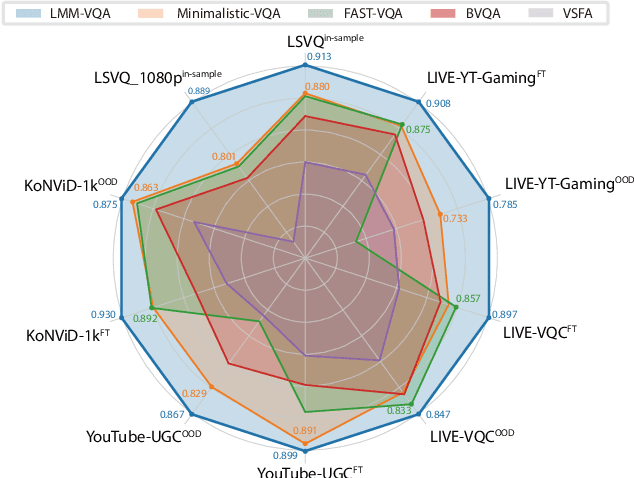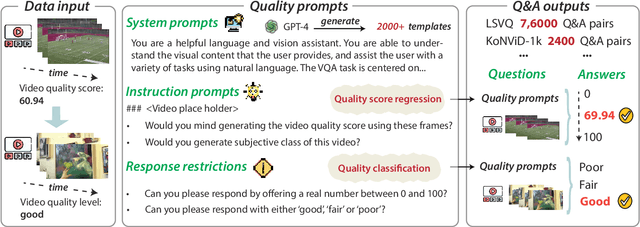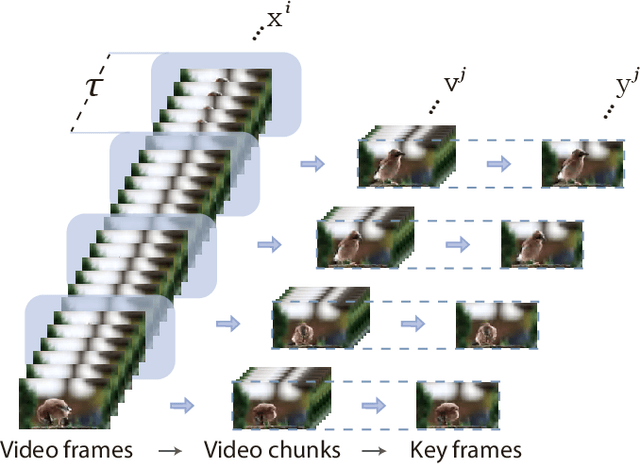Yunhao Li
NTIRE 2025 challenge on Text to Image Generation Model Quality Assessment
May 22, 2025Abstract:This paper reports on the NTIRE 2025 challenge on Text to Image (T2I) generation model quality assessment, which will be held in conjunction with the New Trends in Image Restoration and Enhancement Workshop (NTIRE) at CVPR 2025. The aim of this challenge is to address the fine-grained quality assessment of text-to-image generation models. This challenge evaluates text-to-image models from two aspects: image-text alignment and image structural distortion detection, and is divided into the alignment track and the structural track. The alignment track uses the EvalMuse-40K, which contains around 40K AI-Generated Images (AIGIs) generated by 20 popular generative models. The alignment track has a total of 371 registered participants. A total of 1,883 submissions are received in the development phase, and 507 submissions are received in the test phase. Finally, 12 participating teams submitted their models and fact sheets. The structure track uses the EvalMuse-Structure, which contains 10,000 AI-Generated Images (AIGIs) with corresponding structural distortion mask. A total of 211 participants have registered in the structure track. A total of 1155 submissions are received in the development phase, and 487 submissions are received in the test phase. Finally, 8 participating teams submitted their models and fact sheets. Almost all methods have achieved better results than baseline methods, and the winning methods in both tracks have demonstrated superior prediction performance on T2I model quality assessment.
AGHI-QA: A Subjective-Aligned Dataset and Metric for AI-Generated Human Images
Apr 30, 2025Abstract:The rapid development of text-to-image (T2I) generation approaches has attracted extensive interest in evaluating the quality of generated images, leading to the development of various quality assessment methods for general-purpose T2I outputs. However, existing image quality assessment (IQA) methods are limited to providing global quality scores, failing to deliver fine-grained perceptual evaluations for structurally complex subjects like humans, which is a critical challenge considering the frequent anatomical and textural distortions in AI-generated human images (AGHIs). To address this gap, we introduce AGHI-QA, the first large-scale benchmark specifically designed for quality assessment of AGHIs. The dataset comprises 4,000 images generated from 400 carefully crafted text prompts using 10 state of-the-art T2I models. We conduct a systematic subjective study to collect multidimensional annotations, including perceptual quality scores, text-image correspondence scores, visible and distorted body part labels. Based on AGHI-QA, we evaluate the strengths and weaknesses of current T2I methods in generating human images from multiple dimensions. Furthermore, we propose AGHI-Assessor, a novel quality metric that integrates the large multimodal model (LMM) with domain-specific human features for precise quality prediction and identification of visible and distorted body parts in AGHIs. Extensive experimental results demonstrate that AGHI-Assessor showcases state-of-the-art performance, significantly outperforming existing IQA methods in multidimensional quality assessment and surpassing leading LMMs in detecting structural distortions in AGHIs.
FVQ: A Large-Scale Dataset and A LMM-based Method for Face Video Quality Assessment
Apr 12, 2025Abstract:Face video quality assessment (FVQA) deserves to be explored in addition to general video quality assessment (VQA), as face videos are the primary content on social media platforms and human visual system (HVS) is particularly sensitive to human faces. However, FVQA is rarely explored due to the lack of large-scale FVQA datasets. To fill this gap, we present the first large-scale in-the-wild FVQA dataset, FVQ-20K, which contains 20,000 in-the-wild face videos together with corresponding mean opinion score (MOS) annotations. Along with the FVQ-20K dataset, we further propose a specialized FVQA method named FVQ-Rater to achieve human-like rating and scoring for face video, which is the first attempt to explore the potential of large multimodal models (LMMs) for the FVQA task. Concretely, we elaborately extract multi-dimensional features including spatial features, temporal features, and face-specific features (i.e., portrait features and face embeddings) to provide comprehensive visual information, and take advantage of the LoRA-based instruction tuning technique to achieve quality-specific fine-tuning, which shows superior performance on both FVQ-20K and CFVQA datasets. Extensive experiments and comprehensive analysis demonstrate the significant potential of the FVQ-20K dataset and FVQ-Rater method in promoting the development of FVQA.
Attention to Trajectory: Trajectory-Aware Open-Vocabulary Tracking
Mar 11, 2025Abstract:Open-Vocabulary Multi-Object Tracking (OV-MOT) aims to enable approaches to track objects without being limited to a predefined set of categories. Current OV-MOT methods typically rely primarily on instance-level detection and association, often overlooking trajectory information that is unique and essential for object tracking tasks. Utilizing trajectory information can enhance association stability and classification accuracy, especially in cases of occlusion and category ambiguity, thereby improving adaptability to novel classes. Thus motivated, in this paper we propose \textbf{TRACT}, an open-vocabulary tracker that leverages trajectory information to improve both object association and classification in OV-MOT. Specifically, we introduce a \textit{Trajectory Consistency Reinforcement} (\textbf{TCR}) strategy, that benefits tracking performance by improving target identity and category consistency. In addition, we present \textbf{TraCLIP}, a plug-and-play trajectory classification module. It integrates \textit{Trajectory Feature Aggregation} (\textbf{TFA}) and \textit{Trajectory Semantic Enrichment} (\textbf{TSE}) strategies to fully leverage trajectory information from visual and language perspectives for enhancing the classification results. Extensive experiments on OV-TAO show that our TRACT significantly improves tracking performance, highlighting trajectory information as a valuable asset for OV-MOT. Code will be released.
Learning Radiance Fields from a Single Snapshot Compressive Image
Dec 27, 2024Abstract:In this paper, we explore the potential of Snapshot Compressive Imaging (SCI) technique for recovering the underlying 3D scene structure from a single temporal compressed image. SCI is a cost-effective method that enables the recording of high-dimensional data, such as hyperspectral or temporal information, into a single image using low-cost 2D imaging sensors. To achieve this, a series of specially designed 2D masks are usually employed, reducing storage and transmission requirements and offering potential privacy protection. Inspired by this, we take one step further to recover the encoded 3D scene information leveraging powerful 3D scene representation capabilities of neural radiance fields (NeRF). Specifically, we propose SCINeRF, in which we formulate the physical imaging process of SCI as part of the training of NeRF, allowing us to exploit its impressive performance in capturing complex scene structures. In addition, we further integrate the popular 3D Gaussian Splatting (3DGS) framework and propose SCISplat to improve 3D scene reconstruction quality and training/rendering speed by explicitly optimizing point clouds into 3D Gaussian representations. To assess the effectiveness of our method, we conduct extensive evaluations using both synthetic data and real data captured by our SCI system. Experimental results demonstrate that our proposed approach surpasses the state-of-the-art methods in terms of image reconstruction and novel view synthesis. Moreover, our method also exhibits the ability to render high frame-rate multi-view consistent images in real time by leveraging SCI and the rendering capabilities of 3DGS. Codes will be available at: https://github.com/WU- CVGL/SCISplat.
GSOT3D: Towards Generic 3D Single Object Tracking in the Wild
Dec 03, 2024Abstract:In this paper, we present a novel benchmark, GSOT3D, that aims at facilitating development of generic 3D single object tracking (SOT) in the wild. Specifically, GSOT3D offers 620 sequences with 123K frames, and covers a wide selection of 54 object categories. Each sequence is offered with multiple modalities, including the point cloud (PC), RGB image, and depth. This allows GSOT3D to support various 3D tracking tasks, such as single-modal 3D SOT on PC and multi-modal 3D SOT on RGB-PC or RGB-D, and thus greatly broadens research directions for 3D object tracking. To provide highquality per-frame 3D annotations, all sequences are labeled manually with multiple rounds of meticulous inspection and refinement. To our best knowledge, GSOT3D is the largest benchmark dedicated to various generic 3D object tracking tasks. To understand how existing 3D trackers perform and to provide comparisons for future research on GSOT3D, we assess eight representative point cloud-based tracking models. Our evaluation results exhibit that these models heavily degrade on GSOT3D, and more efforts are required for robust and generic 3D object tracking. Besides, to encourage future research, we present a simple yet effective generic 3D tracker, named PROT3D, that localizes the target object via a progressive spatial-temporal network and outperforms all current solutions by a large margin. By releasing GSOT3D, we expect to advance further 3D tracking in future research and applications. Our benchmark and model as well as the evaluation results will be publicly released at our webpage https://github.com/ailovejinx/GSOT3D.
Human-Activity AGV Quality Assessment: A Benchmark Dataset and an Objective Evaluation Metric
Nov 25, 2024



Abstract:AI-driven video generation techniques have made significant progress in recent years. However, AI-generated videos (AGVs) involving human activities often exhibit substantial visual and semantic distortions, hindering the practical application of video generation technologies in real-world scenarios. To address this challenge, we conduct a pioneering study on human activity AGV quality assessment, focusing on visual quality evaluation and the identification of semantic distortions. First, we construct the AI-Generated Human activity Video Quality Assessment (Human-AGVQA) dataset, consisting of 3,200 AGVs derived from 8 popular text-to-video (T2V) models using 400 text prompts that describe diverse human activities. We conduct a subjective study to evaluate the human appearance quality, action continuity quality, and overall video quality of AGVs, and identify semantic issues of human body parts. Based on Human-AGVQA, we benchmark the performance of T2V models and analyze their strengths and weaknesses in generating different categories of human activities. Second, we develop an objective evaluation metric, named AI-Generated Human activity Video Quality metric (GHVQ), to automatically analyze the quality of human activity AGVs. GHVQ systematically extracts human-focused quality features, AI-generated content-aware quality features, and temporal continuity features, making it a comprehensive and explainable quality metric for human activity AGVs. The extensive experimental results show that GHVQ outperforms existing quality metrics on the Human-AGVQA dataset by a large margin, demonstrating its efficacy in assessing the quality of human activity AGVs. The Human-AGVQA dataset and GHVQ metric will be released in public at https://github.com/zczhang-sjtu/GHVQ.git
MMHead: Towards Fine-grained Multi-modal 3D Facial Animation
Oct 10, 2024



Abstract:3D facial animation has attracted considerable attention due to its extensive applications in the multimedia field. Audio-driven 3D facial animation has been widely explored with promising results. However, multi-modal 3D facial animation, especially text-guided 3D facial animation is rarely explored due to the lack of multi-modal 3D facial animation dataset. To fill this gap, we first construct a large-scale multi-modal 3D facial animation dataset, MMHead, which consists of 49 hours of 3D facial motion sequences, speech audios, and rich hierarchical text annotations. Each text annotation contains abstract action and emotion descriptions, fine-grained facial and head movements (i.e., expression and head pose) descriptions, and three possible scenarios that may cause such emotion. Concretely, we integrate five public 2D portrait video datasets, and propose an automatic pipeline to 1) reconstruct 3D facial motion sequences from monocular videos; and 2) obtain hierarchical text annotations with the help of AU detection and ChatGPT. Based on the MMHead dataset, we establish benchmarks for two new tasks: text-induced 3D talking head animation and text-to-3D facial motion generation. Moreover, a simple but efficient VQ-VAE-based method named MM2Face is proposed to unify the multi-modal information and generate diverse and plausible 3D facial motions, which achieves competitive results on both benchmarks. Extensive experiments and comprehensive analysis demonstrate the significant potential of our dataset and benchmarks in promoting the development of multi-modal 3D facial animation.
LMM-VQA: Advancing Video Quality Assessment with Large Multimodal Models
Aug 26, 2024



Abstract:The explosive growth of videos on streaming media platforms has underscored the urgent need for effective video quality assessment (VQA) algorithms to monitor and perceptually optimize the quality of streaming videos. However, VQA remains an extremely challenging task due to the diverse video content and the complex spatial and temporal distortions, thus necessitating more advanced methods to address these issues. Nowadays, large multimodal models (LMMs), such as GPT-4V, have exhibited strong capabilities for various visual understanding tasks, motivating us to leverage the powerful multimodal representation ability of LMMs to solve the VQA task. Therefore, we propose the first Large Multi-Modal Video Quality Assessment (LMM-VQA) model, which introduces a novel spatiotemporal visual modeling strategy for quality-aware feature extraction. Specifically, we first reformulate the quality regression problem into a question and answering (Q&A) task and construct Q&A prompts for VQA instruction tuning. Then, we design a spatiotemporal vision encoder to extract spatial and temporal features to represent the quality characteristics of videos, which are subsequently mapped into the language space by the spatiotemporal projector for modality alignment. Finally, the aligned visual tokens and the quality-inquired text tokens are aggregated as inputs for the large language model (LLM) to generate the quality score and level. Extensive experiments demonstrate that LMM-VQA achieves state-of-the-art performance across five VQA benchmarks, exhibiting an average improvement of $5\%$ in generalization ability over existing methods. Furthermore, due to the advanced design of the spatiotemporal encoder and projector, LMM-VQA also performs exceptionally well on general video understanding tasks, further validating its effectiveness. Our code will be released at https://github.com/Sueqk/LMM-VQA.
DiffStega: Towards Universal Training-Free Coverless Image Steganography with Diffusion Models
Jul 15, 2024



Abstract:Traditional image steganography focuses on concealing one image within another, aiming to avoid steganalysis by unauthorized entities. Coverless image steganography (CIS) enhances imperceptibility by not using any cover image. Recent works have utilized text prompts as keys in CIS through diffusion models. However, this approach faces three challenges: invalidated when private prompt is guessed, crafting public prompts for semantic diversity, and the risk of prompt leakage during frequent transmission. To address these issues, we propose DiffStega, an innovative training-free diffusion-based CIS strategy for universal application. DiffStega uses a password-dependent reference image as an image prompt alongside the text, ensuring that only authorized parties can retrieve the hidden information. Furthermore, we develop Noise Flip technique to further secure the steganography against unauthorized decryption. To comprehensively assess our method across general CIS tasks, we create a dataset comprising various image steganography instances. Experiments indicate substantial improvements in our method over existing ones, particularly in aspects of versatility, password sensitivity, and recovery quality. Codes are available at \url{https://github.com/evtricks/DiffStega}.
 Add to Chrome
Add to Chrome Add to Firefox
Add to Firefox Add to Edge
Add to Edge